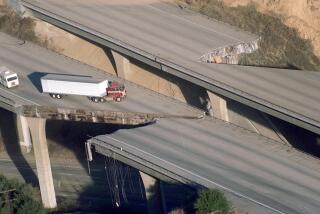Seismology Experts : 2 UCSD Scientists Will Check Soviet Nuclear Tests
- Share via
LA JOLLA — Two internationally prominent seismologists at UC San Diego were named by a private environmental group Wednesday to head a team of U.S. scientists that plans to begin on-site monitoring of underground nuclear tests in the Soviet Union later this summer.
The scientists would undertake independent yearlong measurements--the first ever permitted by the Soviets on their soil--under an unusual agreement signed last month by the Natural Resources Defense Council and the Soviet Academy of Sciences, which is directed by the Soviet government.
The U.S. government, while not openly opposing the agreement, is skeptical that it will lead to a future ban on all testing, as hoped for by the participants.
The appointment of James Brune and Jonathan Berger, both of the Scripps Institution of Oceanography at UC San Diego was announced by the Natural Resources Defense Council, a New York-based group that opposes nuclear proliferation. Brune specializes in seismological theory and Berger is well-known for his expertise in seismological instrumentation. The two have substantial field experience in measuring earthquakes.
In addition, Brune has recorded underground nuclear tests at the Nevada test site and Berger has previously undertaken seismic, non-nuclear measurements in the Soviet Union.
“There is a legitimate scientific question in how to adequately measure the (explosive) yield of Russian tests,” Berger said. “Whether such questions are an impediment to a treaty is political.
“I don’t have a political ax to grind, and I want to distance myself from any political leanings that the Natural Resources Defense Council may have. . . . I have a strong suspicion that the Soviets are doing this for reasons other than just scientific, but that doesn’t mean we can’t perform experiments of important value and interest.”
Brune could not be reached for comment.
The agreement reached last month permits U.S. scientists to set up three monitoring stations within 125 miles of the main test site at Semipalatinsk in the south-central portion of the Soviet Union, said Thomas Cochran, a nuclear physicist and senior scientist at the defense council.
It also calls for a group of Soviet scientists from the Institute of Physics of the Earth, an arm of the Soviet Academy of Sciences, to establish three monitoring stations within a comparable distance of the central Nevada test site on non-government property, he said.
A State Department spokesman said officials have not yet considered questions of visas for Soviet scientists. Science magazine reported last week that the Soviets have promised to admit the U.S. scientists, even if Soviet scientists are refused entry.
Cochran said the objective is to demonstrate that underground nuclear tests can be adequately measured as to numbers and their explosive yield and thus show that questions of verification should not hinder any potential agreement between the two nations on a treaty to prohibit all nuclear test explosions.
The Soviet Union currently has extended until Aug. 6, the 41st anniversary of the dropping of the atomic bomb on Hiroshima, its unilateral ban on testing announced earlier this year. It has repeatedly called on the United States to join the action to make the ban permanent.
President Reagan has countered with an invitation to the Soviets to visit the Nevada test site to observe U.S. monitoring techniques and to join in discussions on how to assure adequate verification of underground tests.
The U.S. government believes that before such a treaty can be negotiated, additional technical work is needed to assure that any violations of a total ban could be adequately detected. Bilateral negotiations on ways to expand the present above-ground test ban treaty to include all tests were broken off in 1982 by the Reagan Administration, in part over Soviet refusals then to permit on-site inspections and because underground testing is the only means currently to upgrade nuclear arsenals.
Cochran and other defense council officials negotiated the agreement over a five-month period, beginning in January. There was no U.S. government participation in the discussions, although Cochran said he has kept the State Department apprised of all negotiations.
Since all monitoring devices will be U.S. made, including sophisticated accelerometers and velocity meters, U.S. government export licenses for shipment to communist nations will be necessary before Brune and Berger can leave with their equipment.
The State Department spokesman said that while the agreement “appears encouraging,” questions of verification leading to a comprehensive test ban treaty must ultimately be resolved at government levels.
More to Read
Sign up for Essential California
The most important California stories and recommendations in your inbox every morning.
You may occasionally receive promotional content from the Los Angeles Times.













